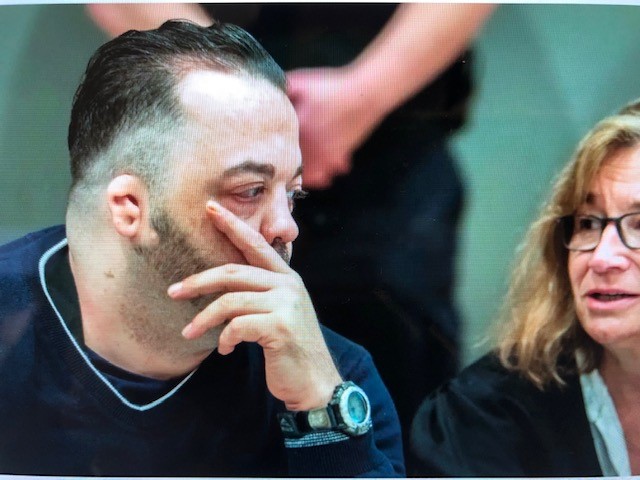Share This Article
“I would like to sincerely apologise to every single individual for all that I have subjected them to over the years”, said convicted murderer Niels Hoegel in a closing statement to the German Court in Oldengurb last Wednesday.
The 42-year-old former nurse, who truly enjoyed causing patients to be put into cardiac arrest because it gave him a sense of happiness to be able to then resuscitate them has now been convicted of eighty-five murders.
He is now believed to be modern Germany’s meanest serial killer.
The sentencing Judge, Sebastian Buehrmann said, “Your guilt is so large that one can’t explain it. It is so large, you can’t show it.”
The 42-year-old was sentenced to life imprisonment, representing his 2nd life imprisonment sentence.
In fact, he was already convicted of 2 murders and a further 2 attempted murders.
In total, Hoegel has been charged with 100 murder counts. He was found not guilty on 15 of those as a result of insufficient evidence. He admitted to killing 43 people, contested 5 but reportedly doesn’t remember the remaining fifty-two.
He told the court in his initial trial, that he had intended to cause cardiac crises in about ninety patients in Delmenhorst as it gave him joy because he was then capable of resuscitating those patients.
Subsequently, he reportedly informed authorities that he also did the same to patients in Oldenburg.
He was employed in a hospital in Oldenburg during the period 1999 to 2002. He was also employed in another hospital near Delmenhorst between period 2003 to 2005. The murders occurred during the period 2000 to 2005 involving victims between 34 years of age to 96 years of age.
The murders
Hoegel would randomly pick patients to insert lethal injections into.
It wasn’t until another nurse who had observed him doing this that he was caught. In 2005, another nurse had caught Hoegel injecting an unprescribed dose of medication into a patient in Delmenhorst. For that, he was sentenced to 7-years imprisonment for attempted murder in 2008.
His killing spree has resulted in a large number of families with pain.
For the prosecution to prove its case against Hoegel, over 130 bodies were dug out and examined.
While he has been convicted of these murders, it is reported that the police believe that Hoegel may have killed more than 200 patients.
One of the victim’s family member Christian Marbach has said, “it can’t satisfy us entirely. It is what was legally possible”. It is believed that the families can now sue the 2 hospitals where those patients were murdered. “We’re finished with the defendant. Now we can bring those people to justice who made his crimes possible”.
The Law on Murder
In NSW, unless the Court orders a non-parole period sentence, the crime of murder carries a penalty of up to life in jail. This is outlined in section 61 Crimes (Sentencing Procedure) Act 1999 (NSW).
A court will only impose a life imprisonment sentence to a convicted murderer if the extent of objective criminality of the offence is so high that a life sentence would be appropriate, keeping in mind the purposes of punishment to protect the community, deterrence, retribution and punishment in the community’s interest.
A crime of murder will have a higher objective criminality if the extent of planning, premeditation and violence is high.
The court, when determining this, will also look into other factors called ‘subjective factors’. These include the offender’s mental and physical health, age, and whether there is genuine remorse and insight expressed, which goes towards prospects of rehabilitation and protection of the community.
If the sentencing court does not impose a life sentence, the court will then impose a sentence that involves a parole and non-parole period.
The non-parole period is the period the offender must spend behind bars before being eligible for release on parole. The parole period is the balance of the sentence that the offender can spend back in the community.
The prospects of an offender’s rehabilitation significantly determine the length of the parole and non-parole period that gets imposed by a court.
As of 1 February 2003, a person convicted of murder will face a standard non-parole period of 20-years. This standard non-parole period is not a mandatory requirement to be imposed by courts. It is only used as a yardstick to assist the sentencing court in reaching a fair sentence and can only be engaged if the murder crime fits in the middle of the range of objective criminality.
What Needs to be Proved for a Murder Charge
A person accused of murder will be found not guilty to murder, unless the prosecution in court prove each of the following elements beyond reasonable doubt:
- The accused did something voluntarily, causing the victim to die; and
- At the same time this occurred, the accused:
- Intended to cause the victim to die; or
- Intended to cause the victim a really serious injury, or permanent or serious disfigurement; or
- Realised the probability of causing the victim to die; or
- Was committing another criminal offence which attaches to it a maximum penalty of 25-years or more imprisonment.
An accused person will also be found not guilty to a murder charge if his/her actions were in self-defence, involuntary conduct due to a medical condition or due to involuntary consumption of drugs or alcohol, automatism or mental illness defence.
As Australia’s leading criminal defence lawyers for murder cases, we appear in all courts.
We offer a free first appointment with an experienced lawyer. Call our 24/7 hotline on (02) 8606 2218 to arrange a consultation today.









